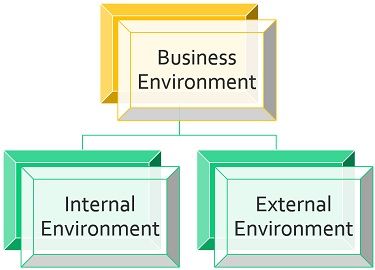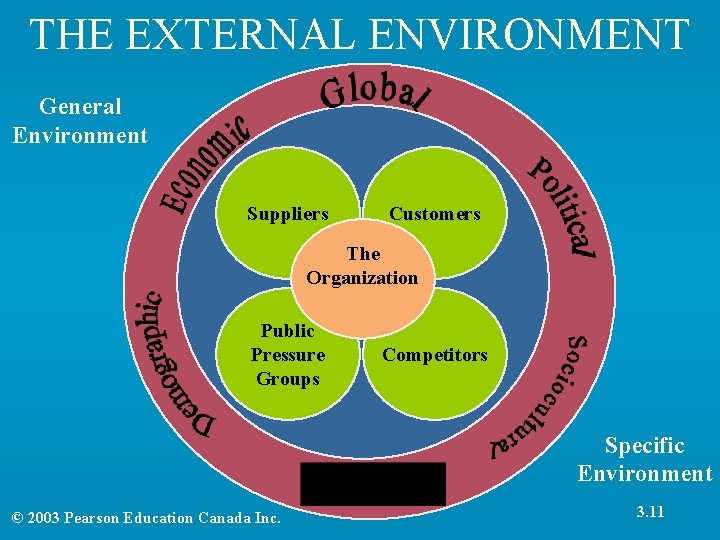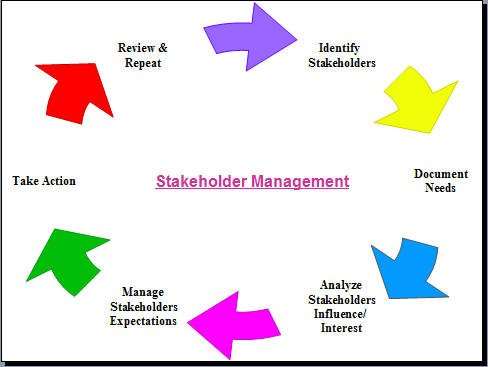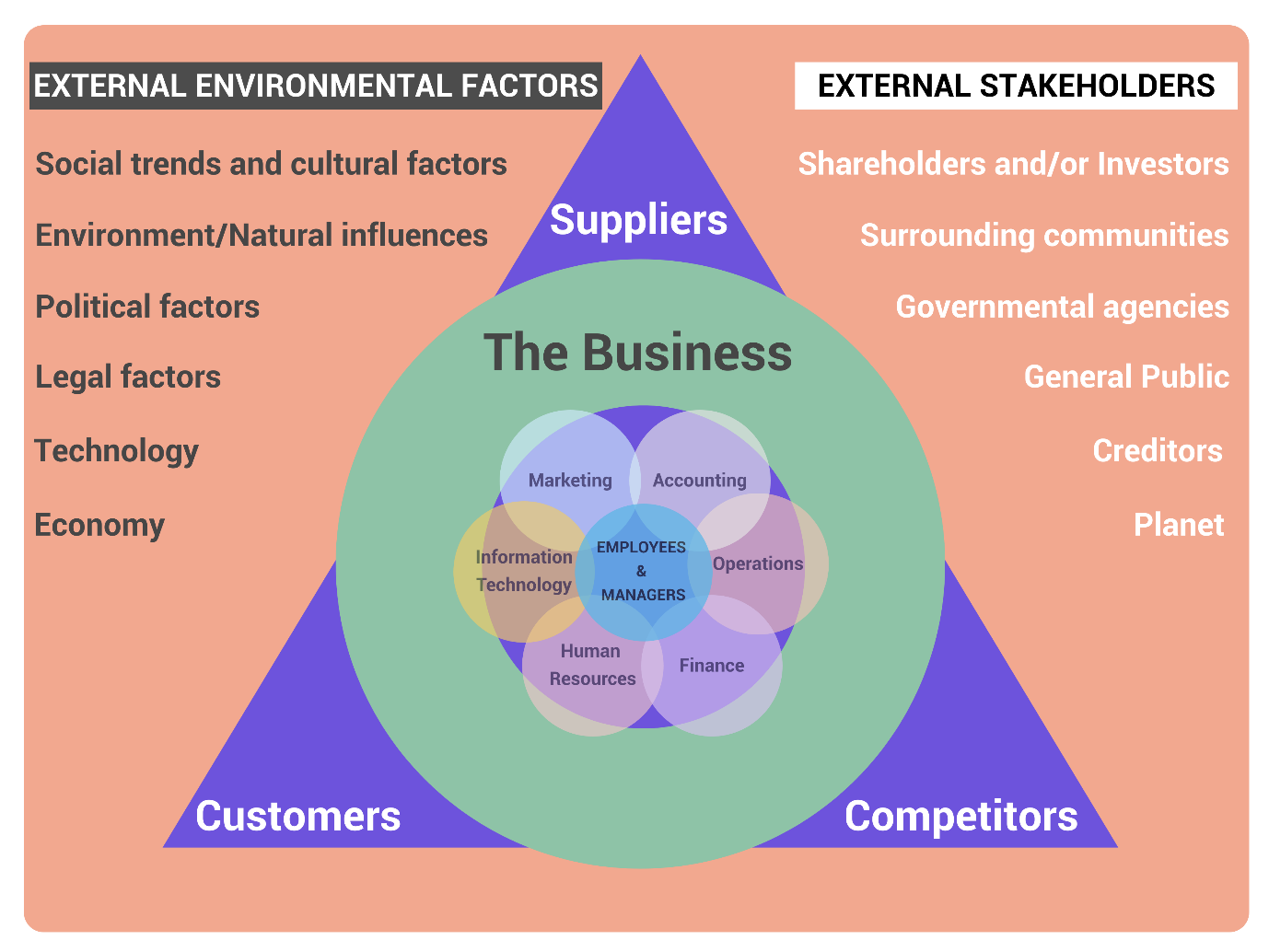Studying and understanding a company's internal and external environments is crucial for its success and sustainability. These analyses provide valuable insights that guide strategic decision-making, help identify opportunities and threats, and enable the organization to adapt to changes effectively.
What is internal and external environment of a company?

Internal Environment:
The internal environment of a company refers to the various elements and factors that exist within the organization and directly impact its operations, culture, and overall functioning. This includes aspects such as the company's organizational structure, leadership style, company culture, human resources (employees, skills, and expertise), management processes, internal policies, resources (financial, technological, physical), and the overall capabilities and strengths that the organization possesses. Read more about internal environment of a company from our professionals here!

External Environment:
The external environment of a company encompasses the broader context in which the organization operates. It includes all the factors, forces, and conditions that exist outside the company and influence its operations, opportunities, and risks. The external environment is typically categorized into several components, including the following:
- Economic Environment: Factors such as economic growth, inflation rates, interest rates, and overall economic stability that can impact the company's financial performance.
- Market Environment: The conditions of the specific industry or market in which the company operates, including customer preferences, market trends, competition, and demand dynamics.
- Technological Environment: Advances in technology and innovation that can impact the company's products, services, and operational processes.
- Social and Cultural Environment: Societal trends, cultural norms, and consumer behaviors that influence how the company's offerings are perceived and received by the target audience.
- Political and Legal Environment: Laws, regulations, government policies, and political stability that can affect the company's operations, compliance requirements, and market access.
- Environmental and Ecological Factors: Considerations related to environmental sustainability, resource availability, and ecological impact, which are increasingly important for responsible business practices.
- Demographic Environment: Characteristics of the population, such as age, gender, income levels, and population growth, that can influence market demand and consumer behavior.
- Global Environment: Factors related to international markets, trade policies, exchange rates, and geopolitical events that can impact the company's global operations and expansion strategies.
- Supplier and Partner Relationships: The dynamics of relationships with suppliers, distributors, partners, and other stakeholders that affect the company's supply chain and overall business network.
- Competitive Environment: The competitive landscape within which the company operates, including the strategies and actions of competitors that can shape the company's market position.

Understanding both the internal and external environments is essential for developing effective strategies, making informed decisions, and adapting to changing circumstances in the business world. It helps companies capitalize on opportunities, mitigate risks, and maintain a competitive edge.
Here's why it's important:
1. Informed Decision-Making:
Understanding the internal environment (organizational structure, culture, resources, capabilities) allows leaders to make informed decisions about resource allocation, goal setting, and strategy development. Similarly, understanding the external environment (market trends, competition, regulatory changes) enables the company to identify potential risks and opportunities, leading to better decision-making.
Informed decision-making is the cornerstone of effective management and strategic planning. A thorough understanding of both the company's internal strengths and weaknesses, as well as the external market trends and competitive landscape, empowers decision-makers to make choices that capitalize on strengths, mitigate weaknesses, seize opportunities, and navigate challenges effectively. Without this understanding, decisions could be made based on assumptions, leading to suboptimal outcomes and missed opportunities.
2. Strategic Planning:
A thorough analysis of both internal and external factors is essential for developing a coherent and effective strategic plan. This plan aligns the company's strengths and weaknesses with the opportunities and threats present in the external environment, leading to strategies that maximize competitive advantage.
3. Competitive Advantage:
Studying and comprehending the company's internal and external environments are pivotal for gaining a competitive advantage. This advantage goes beyond simply outperforming competitors; it allows a company to shape its strategy, innovate, and adapt to changes effectively. By leveraging its strengths and understanding the market landscape, a company can create a sustainable and unique position that leads to growth, profitability, and long-term success.

4. Risk Mitigation:
Studying and understanding the company's internal and external environments provide a foundation for effective risk mitigation. By identifying potential risks such as changes in consumer preferences, technological disruptions, economic downturns, or regulatory changes, anticipating threats, and preparing strategies to address them, a company can enhance its resilience, protect its assets, maintain operational continuity, and safeguard its long-term success in an increasingly uncertain business landscape.
5. Innovation and Adaptation:
By comprehending external trends, a company can spot emerging opportunities and changing customer needs. This insight fuels innovation and allows the organization to adapt its products, services, and processes to remain relevant and competitive.
In essence, understanding the company's internal and external environments fosters a culture of innovation and adaptability. It enables the company to capitalize on opportunities, respond effectively to challenges, and continuously evolve to meet changing market demands. By integrating these insights into its operations and strategies, a company can create a sustainable pathway for growth and success.
6. Resource Optimization:
Understanding the internal environment aids in resource allocation and utilization. It helps identify areas of inefficiency or underutilization, leading to better allocation of funds, human resources, and other assets.
In summary, understanding the company's internal and external environments is instrumental in optimizing resource allocation and utilization. It allows the company to leverage its strengths, address weaknesses, capitalize on opportunities, and mitigate risks. By aligning resource allocation with the ever-changing business landscape, a company can enhance its competitiveness, profitability, and long-term sustainability.
7. Effective Communication:
A clear understanding of both internal and external environments enhances communication within the organization. Leaders can convey goals, strategies, and rationale more effectively, fostering alignment and motivation among employees.
8. Long-Term Sustainability:
Staying attuned to the external environment is essential for a company's long-term survival. Adapting to evolving trends, customer preferences, and technological advancements helps a company remain relevant and sustain growth over time.
9. Stakeholder Management:
Understanding external factors like market trends, societal changes, and regulatory shifts helps a company manage relationships with various stakeholders, including customers, investors, suppliers, and regulatory bodies.

In summary, understanding the company's internal and external environments is essential for effective stakeholder management because it provides the insights necessary to anticipate and address the needs, concerns, and expectations of different stakeholder groups. By aligning its strategies and actions with stakeholder interests, a company can build positive relationships, enhance its reputation, and foster a more sustainable and successful business ecosystem.
10. Performance Evaluation:
Comparing internal performance metrics against external benchmarks provides insights into how well the company is doing in relation to its competitors and the market as a whole. This data informs ongoing improvements and adjustments.
In summary, performance evaluation isn't an isolated examination of internal metrics; it's a holistic process that considers both the company's internal strengths and weaknesses and the external factors that influence its operations. This comprehensive approach ensures that performance metrics are relevant, actionable, and accurately reflect the company's progress within its industry and market environment.

In essence, studying and understanding both internal and external environments equips a company with the knowledge necessary to make informed, strategic decisions that drive growth, mitigate risks, and enhance overall competitiveness in a dynamic business landscape.
